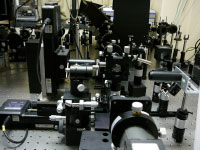Feature
Ultra-fast, terabyte-order holographic memory for medical applications
Toyohashi Tech’s Mitsuteru Inoue describes the development of the next generation holographic memory for applications including storage of medical data of patients.
Every decade or so new data storage technology supersedes current ideas. Compact discs replaced audiotape, which were then eclipsed by DVDs, which are now being pushed aside by Blu-ray discs. Toyohashi Tech researchers are currently perfecting yet another technology that will take data storage to the next level.
“The era of 3D imaging is just beginning and although today’s 3D TVs are little more than toys, it is clear that information displayed in 3D is going to be the way of the future,” says Mitsuteru Inoue, of the Department of Electrical and Electronic Information Engineering. “This will require huge increases both in data storage capacity and in data transfer rates.”
Whereas a Blu-ray disc can store 50 Gbytes of data, tomorrow’s discs will be required to store 1 terabyte or more to cope with the demands of 3D imaging. Inoue is convinced that the technology to make this possible is holography.
Simply put, holography uses light scattered from an object to record and reconstruct the object for viewing in three dimensions. Inoue and his team have developed a collinear phase-lock holographic memory that uses the interference caused by two overlapping laser beams—an information beam and a reference beam—to record holographic data on a disc. Moreover, the system employs a magneto-optic spatial light modulator that enables the recording of multi-level ‘pages’ (three-dimensional volumes) of data at the same time, and these can be represented as two-dimensional patterns on a new type of disc made of photo-polymer material also devised by the researchers.
“So instead of 1-bit sequential recording used in today’s DVD or Blu-ray technologies, we can instantly record a million bits per page,” says Inoue. “And because recording pages is performed simultaneously on multi-levels, the technology is capable of ultra-fast writing speeds of 1 gigabit per second to a disc with a capacity exceeding 1 terabyte—enough to store 200 movies, for example.”
The technology has already been proven in the lab and Toyohashi Tech has set up a venture company called Optware to exploit its potential. Now the researchers are working to perfect data transfer rates and storage density, and are also working on a data erase technique to make rewritable discs possible.
Inoue sees the technology being used by entertainment and consumer electronics industries to replace current disc technologies, and for news media, business, and industrial archiving. In the area of medicine, hospitals will be able to store entire medical histories of patients over their lifetime.
“Hospitals don’t have the space to store such records today, so doctors are forced to throw out patient data of old MRI, CT and PET images,” says Inoue. “A holographic based archival system will rectify this problem.”

Mitsuteru Inoue

Optical table showing the collinear phase-lock holographic memory recording system


